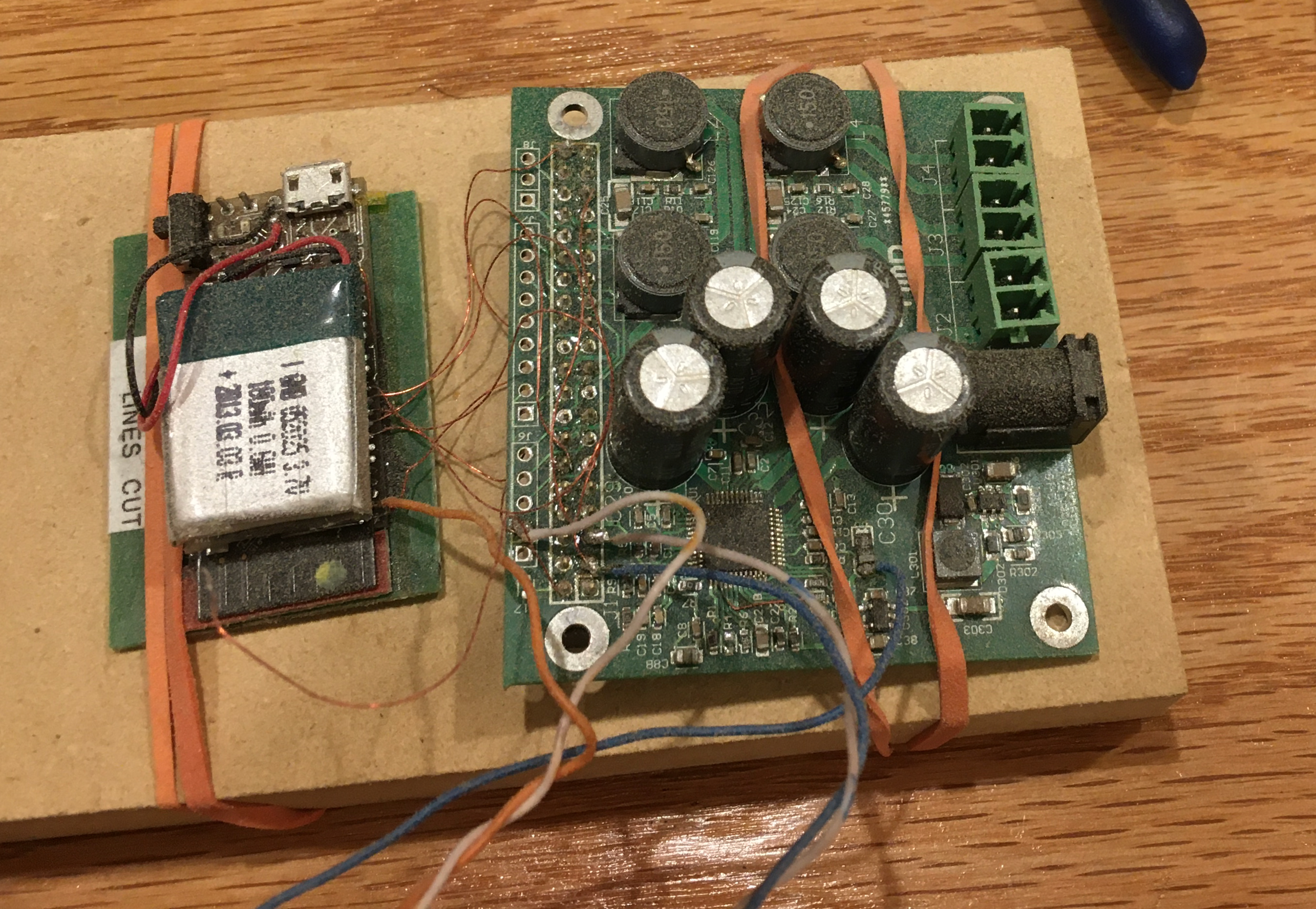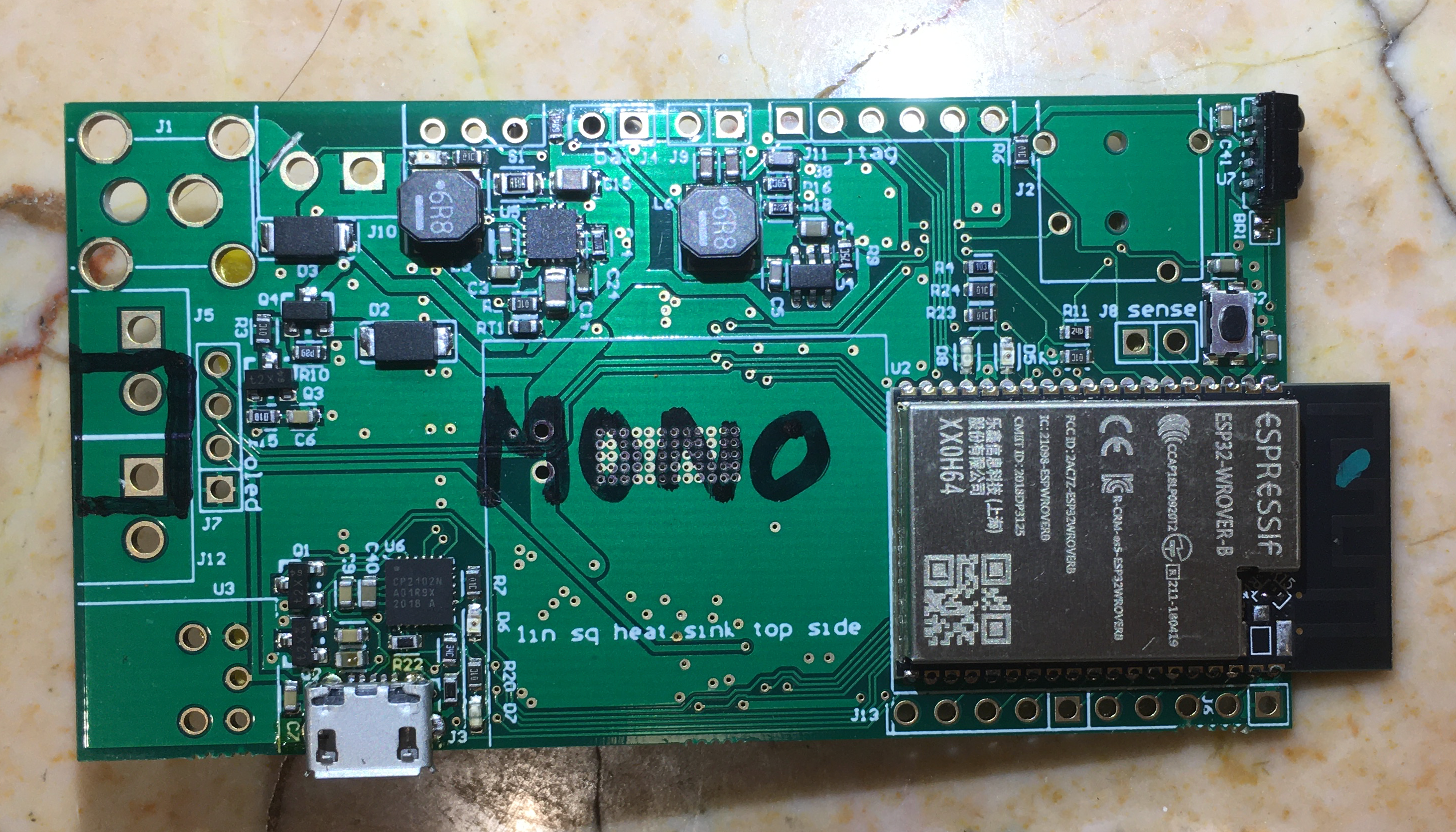The SqueezeAmpToo is designed by Dave Viberg and Chuck Rohs and was completely inspired by the SqueezeAMP project and the SqueezeESP project.
While this project borrows a lot from the SqueezeAmp, it has some differences for both reduced cost and added functionality. These include:
- only 2 cells supported for reduced power consumption/heat.
- larger board to add a better performing 1 inch 2 heat sink for 16V operation. The board is now basically the size of a dual 18650 battery pack.
- a cost reduced charger and buck regulator
- onboard USB to serial interface for easy initial programming along with a JTAG port.
- V2 fixes a charger wiring error, low voltage cutoff for 3.3v buck, headphone and powerjack footprints.
- V2 adds an optional spi display header, rotary encoder and button board with an I2C expander, a daughter board to drive ws2812s, a battery pack thermister, and IR remote control daughter board.
The squeeze amp board is running in the box show below. To run this board, in particular the RGB LEDs and I2C buttons on the gpio expander, the SqueezeAmpToo Software should be used. This software is a fork of the SqueezeEsp project referenced above.
The RGB LEDS are illustrated in the animated GIF (it will only loop once in certain browsers, click on the image to see it in action if it isn't animating). This little box has 31 ws2812's (144 leds/meter density) along with the very nice/quasi expensive ssd1322 256 x 64 OLED. While the leds might be a little bit hokey, the center led changed color to indicate the battery voltage. This is all described in the Readme.
We've got a PurePath Console Motherboard board on order, so we can use the onboard DSP of the TAS chip. This will allow us to stop messing with the equalizer running on the ESP and hopefully tune the stereos to get the most out of the speakers.
We've done some playing around with a mono version of the board. It is easy to hack to make it work that way, but again, the purepath software is probably required to do a proper job of it.
We're using Protel 99SE for schematics and routing. The current version, V2, files are here, use at your own risk, we have not yet done a board run on these files. Also if you use them, please give credit to Dave Viberg, Chuck Rohs, and philippe44 from whom we leveraged the initial schematics. Standing on the shoulders of giants and all that....
The CAM PACKAGE is here.
The BOM is here. Note however this is the V1 BOM. It does not contain the daughterboard parts, But should get you started.
As stated above Software is here and here.
The pinouts for the IR receiver are wrong. Pins 2 and 3 are transposed.
This project started out from experimenting with the squeezeamp software. I first got it working with a HiFiBerry clone. From there it got out of hand and we started building hardware and modifying software and ended up with the current generation board.
This design was prototyped using the squeezelite-esp32 code on a WROVER board that was fly-wired to a clone of the HiFiBerry AMP+. This audio board uses the TAS5713, and as such an appropriate driver needed to be written to use the squeezelite-esp32 code. That is now all ancient history but the picture and development is documented here for posterity (covered in CNC router dust):
For anyone else wanting to replicate this configuration, The WROVER is hooked up to the HiFiBerry as follows:
| WROVER Pin# | HiFiBerry 40pin connector number | Function |
|---|---|---|
| 8 | 40 | I2S-SD |
| 9 | 12 | I2S-CLK |
| 10 | 35 | I2S-LRCLK |
| 11 | 5 | I2C-SCL |
| 12 | 3 | I2C-SDA |
| 1 | 6 | GND |
Depending on your dev board, you may be able to pull power from the pi amp, but I would recommend separate power supplies, and just tie the grounds together.
As of this writing sle118's repo contains the TAS5713 driver I developed. To test this out I used the sdkconfig "SqueezeAmp8MBFlash-sdkconfig.defaults". The code here was modified to replace "CONFIG_DAC_CONFIG" with "NULL" so that the dac_config NVS parameter would not be overridden.
The dac_config was set to:
- model=TAS5713,bck=33,ws=25,do=32,sda=27,scl=26
Also note that the partition map needed to be changed so that the OTA application resides at 0x160000.
Since then, the V1 squeeze-amp-too has been built, and while there are a few errors, it performs remarkably well. The (modified for mono) V1 board is pictured here:
It includes the following:
- Espressif's WROVER board based on ESP32 WiFi/BT chipset (built-in antenna)
- WiFi / BT connectivity
- TI's TAS575x stereo class-D amplifier for up to 2x20W
- 1"^2 heatsink to handle the TAS and WROVER heat
- Built-in battery charger 2 Li-ion cells in series and automatic switch between battery and external power
- Direct speaker output
- Jack 3.5mm for analogue line-out with insertion detection
- SDPIF optical output
- Connectors for GPIO
- Onboard CP2102N for programming, with rx/tx leds. (CP2102 must be programmed with silabs software for the leds to work, i.e. chaning the gpios for alternate functionality)
- Charge LED
- Two general purpose LEDs (red/green)
Connectors:
- J1 - Power Jack rated for 5A (PJ-047AH)
- J2 - Headphone Jack
- J3 - USB Micro B (for initial programming/debug)
- J4, J9 - Battery connectors
- J10 - .15" header, alt power
- J5, J12 - .15" speaker connectors
- J6, J13 - 5 pin .1" headers, for various gpio.
- J7 - 4 pin .1" header for sh1105 OLED display
- J11 - 6 pin .1" header for JTAG
With the squeezelite-esp32 software, you can (as quoted from the SqueezeAMP)
- Stream from LMS and send audio to the build-in amplifier, the line-out jack, the spdif connector or another bluetooth speaker. You can also use an external I2S DAC if you connect it to the general purpose 5/8 pins connector and tweak the software. Synchronization works.
- Stream from a Bluetooth device and send audio to the same outputs, except of course for sending to another bluetooth speaker ... There is no guarantee of audio/video synchronization at this point
- Stream from an AirPlay1 device (iPhone, iTunes ...) to the same outputs, including to a bluetooth speaker. Synchronization works.
- Add your own buttons, rotary encoder and map/combine them to various functions (play, pause, volume, next ...
- Use IR control by adding a simple receiver compatible with 38kHz device (no pullup resistor or capacitor needed)
- Add a display like this one which can be directly connected to the 6-pins header. Currently, SSD1306, SSD1326/7 and SH1106 displays are supported.
- Support for WS2812 RGB LED VU meters (other coming soon). Supported with a 5v buck converter with enable
- Rotary encoder daughter board with IIC/SPI gpio expanders




